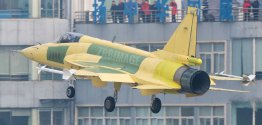Fragment on the conclusions of FULL AVIACION on the Danish F-16 offered to Argentina:¿Puedes explicar los detalles?
"Proposal to Argentina
Regarding the specimens offered to Argentina, of which the Argentine Air Force (FAA) has detailed technical information. Corresponds to 12 aircraft* with an average of 1200 remaining hours, at a cost of 15 million dollars per aircraft, this figure includes staff training accompanied by a minimum stock of spare parts. It should be added that the offer does not include tools, with which to serve the fighters or ground support equipment (GROUND SUPPORT EQUIPMENT-GSE). Nor is there anything in the proposal, referring to weapons, since it would already be another subsequent contract, and in that case, with the United States.
*Author's Note: When purchased material is "used", a much higher quantity than the requirement must be incorporated, for obvious reasons. Therefore, the number of units offered is insufficient.
It should be added that the F-16 system, beyond its versions, requires various logistics support contracts with Lockheed Martin, such as: Contractor Engineer Technical Services (CETS), Technical Coordination Group (TCG), International Engine Management Program ( IEMP), among others, to be able to operate the weapons system. (See the case of Iraq and the consequences of not accessing them; in that same aspect, see support contract for Oman).
On the other hand and beyond the criteria used to calculate the flight time of a weapon system; An F-16 from the early 1980s, like the MLUs, costs 60% to 80% more per flight hour than a Block 52 from this century. Not to mention, in comparing the operating costs of an MLU, with those of an F-16 0 hours.
This is not a simple speculation in passing, since aircraft with 40 years of use require more intense maintenance and inspection processes. They are prone to unexpected failures, while a greater number of Service Bulletins (BS) must be applied. The same increasingly frequent and costly, since the repairs are of the Major type.
Saving the distances, although the Danish have applied methodically and orderly, all the reforms and reinforcements in the cells, together with what is mandatory in the manual; the more than 40 years of intense use, the structural fatigue, the obsolescence and the hustle and bustle, do not forgive. For more remaining hours that remain in the structures.
As for the Pratt & Whitney F100 220E propulsion system (3300 litres/hour - average consumption in tactical flights), it has not been manufactured for years, for this reason Denmark had to buy used PW220E engines in 2013, in addition to contracting in 2019 a contract with the company Patria Belgium Engine Center SRL, based on comprehensive maintenance. Preventing in this way, mitigating the problems inherent to the wear of the propulsive system. Meanwhile, after the February 2021 incident, with a Belgian F-16 MLU, Patria signed a specific contract with Pratt & Whitney for one-off parts. That is, more maintenance costs, which in turn are transferred to the operating cost. It is worth mentioning that the F-16 Block 40/52 currently in service with the USAF use the F100-PW-229.
In general terms, the F-16 A/B MLU of the European contract is closer to the flight hour costs of a new twin-engine MiG-35, for example, than an F-16 Block 40/52 with the Common Configuration Implementation Program (CCIP) applied.
Conclusions
The Argentine Air Force needs a fourth generation system, whose platform has fifth generation equipment (4++), with which to face the next 40 years. Meanwhile, the system to be adopted must inevitably be sustainable throughout its life cycle, which means that its operating cost is reasonable and its logistics support maintains a projection over time, beyond acquisition costs.
On the other hand, with the transformation of the current F-16 Viper 40/52 of the USAF fleet to the F-16V Block 70, a new standard is born, which will reach a minimum of 2048. From which it follows that an MLU , which does not have the remaining life, nor the structural qualities that would allow it to admit a SLEP of this magnitude, does not qualify.
Finally, it is clear that there are political pressures and that at this point Argentina has very few options when it comes to incorporating a fighter. However, if the way forward is down the F-16 path, clearly this is NOT the F-16 model that will see us through decades to come."
More clearly impossible .....
Greetings from Argentina.



